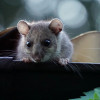Ever since we domesticated the first plants for food production, humanity has been dragged into the age-old arm’s race that exists between our crops and their pathogens...
The impact of one single crop pathogen on human society can be of a dreadful scale, especially when our crops are not naturally protected against them. The best example to illustrate this is the potato epidemic that caused the Great Irish famine in the mid-19th century. The culprit, an American microbe named Phytophthora infestans, crossed the Atlantic by ship, reached the European continent and wiped out entire potato harvests over various consecutive years. The impact was most devastating in Ireland, where people were highly dependent on one single variety of potato that did not bear strong natural resistance against the pathogen. About a million people died of starvation and another million or more were forced to leave the country. The famine reduced Ireland’s population by 25%, and the country has still not yet recovered to its original population size, even today.
It would, nonetheless, be very wrong to think that the threat of starvation due to crop pathogens is a problem of the past. According to the Food and Agriculture Organization (FAO) of the UN, at least 20% of global food production is lost due to plant disease and over 800 million people are chronically undernourished worldwide. In addition, the globalisation of trade since the Second World War combined with a lack of thorough disease control has allowed the spread of local pathogens to every corner of the world. And now, with the threat of climate change coming nearer and nearer, the future of agriculture in the face of disease becomes more uncertain. Simply eradicating pathogens is, however, practically impossible and ecologically irresponsible. What would provide us with more sustainable ways of combating crop disease and hunger, and equip us better for the changes to come, is a thorough understanding on how plant pathogens spread, colonise and adapt to their hosts in the first place, so that our agricultural systems can always be a step ahead of disease. For that, the history of a crop pathogen and its spread is a great starting point.
Studying the evolutionary history of plant pathogens, and tracking their routes of invasion, has always been difficult, however, because the historical crop disease records are sparse in this respect. Moreover, these records often provide misleading information on the spread of the disease as it can take a long time before the presence of a pathogen becomes apparent. This means that its true arrival time and subsequent adaptation to its new environment might have happened years before historical documents suggest. In recent years though, genetic sequencing technologies have taken a giant leap forward such that it has now become possible to sequence entire genomes of all kinds of organisms – even dead ones - rapidly, cheaply and accurately. Scientists have developed intricate methods to obtain the remaining DNA from tissues that have been dead for thousands of years and have made astonishing discoveries. For example; through the few micrograms of DNA obtained from a Neanderthal bone, it was discovered that we, Homo sapiens, actually intermixed with this other species of hominid. For decades, such an idea had been thought impossible. And while most ancient DNA studies focused on humans and other animals, more recently scientists have begun to find other applications for this promising field of genetics.
To witness significant evolutionary change in humans – organisms with a long generation span - you need to go deep back in time and study them over a couple of centuries or millennia at the least. Microbes on the other hand, are organisms with much shorter generation spans. In their evolutionary context, time is warped: 100 years of change could be equal to millennia of evolution for us. With this idea in mind, scientists started to retrieve microbial pathogen DNA from the dead, dried leaves of old herbaria tucked away in the dark and dusty libraries of botanical gardens worldwide. Indeed, thanks to botanists from the 17th, 18th and 19th century, we have a magnificent plant collection covering all existing and also many extinct species of plants in all forms: old and young, tall and small, healthy and sick. Sequencing the DNA of historical microbes in herbarium samples revealed information on plant pathogens we couldn’t have obtained in any other way. Pioneer studies mostly concentrated on Phytophthora infestans and tracked down the original strain and the invasion route that brought it to Europe, planting death and despair wherever it went.
Through the University of Montpellier, I had the chance to explore this exciting field of ancient genetics, herbarium specimens and pathogen histories myself. For that, my destination was a very special place: the tiny French island of La Réunion, which lies in the middle of the Indian Ocean. There, a couple of scientists at the Research Institute for Agriculture and Development had started to study infected herbarium samples of citrus plants to find out more about the bacterial pathogen Xanthomonas citri (hereafter Xac). Although absent in Europe thanks to the strict border control and quarantine policies of the EU, this microbe is a nuisance in the rest of the world, causing lesions on the fruits and leaves of citrus plants, and premature drop, which makes the fruits inedible and unsellable. When I arrived on la Réunion, very little was known about this pathogen: its origin was thought to be Asia and it was believed to have spread to the rest of the world in the past century and a half. But how and when it reached those places, including La Réunion itself, was unknown; nor was it clear whether the spread had been facilitated by human trade and transport. And scientists also had no idea how fast it could adapt and evolve. These things are nevertheless documented in its inner "genomic" book, which reveals more than any historical document in the world.
Obtaining the DNA sequence of decades-old dead microbes is not an easy task. I spent the first two and a half months of the project in the lab, desperately trying to avoid contamination from modern Xac samples and testing multiple methods to obtain as much DNA as possible from the dead tissue. After getting the sequences back, we spent a further month trying to clean and organise the heavily-damaged data. In the meantime, I was also enjoying to the full the natural wonder that is La Réunion.
Being a young island, moulded and shaped by the violence of a fierce volcano, it is a strange little paradise for those who love to wander and hike. The landscape is scarred by the violent natural forces that created it, with slopes climbing up steeply from the coast to reach dizzying 3000m heights and then plummeting into a clover-like calderas that arose when the volcano came to its own brutal end, crashing down half a million years ago. Although the coast has been intensely urbanised, the inner parts of the island still remain wild. The hectic landscape, with razor-sharp cliffs, deep ravines, abrupt peaks and the impressive, straight walls of the calderas has created a lot of opportunity for a fantastic variety of natural communities to settle: grasslands, forests, jungles, rivers and waterfalls – while making it very hard for humans to reach. In the south-eastern end of the island a younger, very lively little brother of the now-extinct volcano sprung up about 500,000 years ago and is now one of the most active volcanoes in the world. Also here, landscapes vary immensely, with cool, green grasslands rolling into vast, red sand plains as you climb higher and higher into the mouth of the dragon. It is surreal to think that one can find himself in the prairies of the Alps, the plains of Tatooine, the forests of Middle-Earth and the jungles of Jurassic Park on the very same piece of land that only just stretches 63 km long.

The caldera of Cilaos lies in the centre of la Réunion and is the result of the main volcano's collapse half a million years ago.
Looking back, it is hard to decide which of all the fantastic things I saw in La Réunion struck me most. Was it that humpback whale jumping metres high into the air, or the view of two encircled worlds as I stood on the ridge that separated one caldera from the other? Was it the splendid primary jungle that lies tucked between the calderas, bursting with life, covered in fog; or the view of the milky way from a white-sand beach; or the eerie look of a gigantic blood moon crossing the skies? If I had to pick, I believe it would be the view of streams of lava pouring out of the wounded earth one night in April, when the island’s volcano erupted. The trembling and growling underneath our feet, the sight of deep-cutting, red-glowing crevices from which fiery lava was spitting, and the slowly-growing, red tongues of liquid stone rolling towards the sea made me realise what a strange, powerful force is hidden deep in the Earth, one that can so easily destroy life, and give birth to it at the same time. Even though it was the very same Earth that was being vomited onto the surface before my very own eyes, it was by far the most unearthly and surreal thing I’ve seen and felt in my life.

The 500 thousand year old volcano in the South-East of La Réunion is one of the most active in the world. Here we see its main crater, le Dolomieu, in the back, and the much smaller and younger crater Formica Leo in front, which is thought to have been formed in the mid-18th century.
While I was able to witness these spectacular natural scenes on the weekend, I was gradually being absorbed with the wondrous feeling of obtaining scientific results and acquiring a better understanding of our study system, Xac during the week. Once our historical DNA sequences were ready for analysis, we paired them up with DNA sequences of contemporary Xac strains from the entire world. This revealed the genetic relationship between historical and modern strains and lifted a tip of the curtain that covers its history. Our analyses confirmed what historical documents had suggested; that Xanthomonas citri is indeed native to Asia. However, something that historical documents cannot accurately report is the arrival date of a pathogen to a new territory. With a large enough sample size, and the availability of historical genomes, we were able to estimate this for the strains that have colonised the islands of the southern Indian ocean: Comoros, Mayotte, Mauritius and la Réunion itself. Our analyses suggested that the bacterium arrived first in Mauritius and la Réunion around 1850. Curiously, this falls shortly after the abolishment of slavery, which caused a major loss of work force on the sugar cane fields that largely fuel the economy of both islands. To replace the now-freed slaves, the French and British colonists brought large groups of workers from other colonies to the islands: many of them coming from India and China. Although we have no direct proof, one could speculate that it was this big migration wave that brought the first Xanthomonas citri to the Indian Ocean, as the migrants carried plants and seeds with them.

The primary forest of Bélouve lies on a plateau in between two calderas. The combination of past volcanic activity, a high altitude and humidity brought by fog that builds up here has given rise to this fantastically biodiverse tropical jungle.
Another surprising finding was the close genetic relationship between Xac strains of La Réunion and another French island, Martinique. Martinique, however, is located in the middle of the Caribbean Sea, half a world away from La Réunion. How then, can it be that the two strains are so closely related? One possibility is that Xac was transported to Martinique through human traffic and trade, which has created a quick connection between the two French islands. Our results thus suggest that human mobility has possibly played a large role in the spread of the pathogen and reconfirms the importance of thorough border controls and quarantine policies for crops.
How else can these fundamental studies benefit society, you might ask? Apart from creating a historical record on crop disease, such phylogenetic studies can have direct applications. We were, for example, not only able to date the arrival of Xanthomonas citri to the Southern Indian Ocean, but also to estimate a mean mutation rate for its genome. This is a measure for the pace at which mutations occur in the Xac genome, and therefore also for the speed at which it is able to evolve. Such measures are incredibly useful when designing strategies to combat the disease: it gives us an idea how quickly it could adapt and overcome a pesticide, for example. Thanks to such knowledge, we can make sure we’re always a step ahead of the pathogen in the eternal arms race we have found ourselves locked in since our hunter-gatherer ancestors started growing the first crops.

Sunrise view over the highest mountain of la Réunion, the Snowpeak, and the surrounding calderas. In front, smaller, extinct craters from times long-gone spring up across the landscape. The picture was taken from the grassy, rural plains that lie at the foot of the volcano. Here, cows graze and oaks grow, as if it were a little piece of Europe brought to this remote island.
Five months after my arrival in La Réunion, I was on my way again to the airport, with the scientific report of my project and a fantastic collection of unforgettable memories as extra luggage. More than anything, I felt extremely lucky that I had been given the chance to travel there and explore the island’s beauty and magical phenomena, while also learning so much on the evolution of crop pathogens and the unimaginable potential that lies hidden in the millions of herbarium samples across the world. Now that we have the tools to genetically study them, an entire new world of adaptation and evolution has opened up to us, that will certainly provide answers and applications when we face agricultural crisis due to pathogens, climate change or anything else. Most to thank are all those botanists from centuries past which, although oblivious of the true value of their work, knew how to treasure the accumulation of basic, fundamental knowledge about the world that surrounds us. That was one of the key lessons learned while staying in la Réunion; collecting information and knowledge about the natural world just for the sake of curiosity is never in vain, for one can never know what applications we may find for it in the future. And in that aspect, the potential of herbarium libraries is unmeasurable. If only a few historical strains were able to elucidate key aspects of Xanthomonas citri’s evolution and spread, can you imagine what we can learn from the immense natural library that all those botanists from centuries ago left us?









Comments
Add a comment